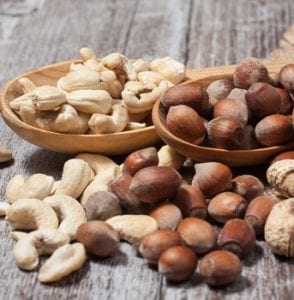Written by Harold Oster, MD. Consumption of tree nuts as snacks is associated with a reduction in the risk of metabolic syndrome.
 Metabolic syndrome is a group of risk factors for coronary artery disease and diabetes. The definition of metabolic syndrome varies among medical organizations but generally requires three of the following traits: increased waist circumference (signifying central adiposity), elevated blood pressure, elevated glucose level, elevated triglycerides, and a low level of high-density lipoprotein (HDL)1. The prevalence of metabolic syndrome is increasing worldwide, mainly due to the increase in obesity and a sedentary lifestyle. Tree nuts are a low-glycemic index food and have been shown to have beneficial effects on glucose control in diabetics2.
Metabolic syndrome is a group of risk factors for coronary artery disease and diabetes. The definition of metabolic syndrome varies among medical organizations but generally requires three of the following traits: increased waist circumference (signifying central adiposity), elevated blood pressure, elevated glucose level, elevated triglycerides, and a low level of high-density lipoprotein (HDL)1. The prevalence of metabolic syndrome is increasing worldwide, mainly due to the increase in obesity and a sedentary lifestyle. Tree nuts are a low-glycemic index food and have been shown to have beneficial effects on glucose control in diabetics2.
Kate Sumislawski et al. studied the beneficial effects of replacing typical carbohydrate snacks with tree nut snacks on the risk of metabolic syndrome in young adults. Participants between 22 and 36 years old with at least one of the five traits of metabolic syndrome were recruited for the study. At baseline and the end of the study, participants were assessed for dietary intake, vital signs, anthropometrics, physical activity measured by a wrist accelerometer3, resting energy expenditure measured with a validated in-office system4, and visceral adiposity on CT imaging5. Blood was tested for insulin, fasting glucose, lipids, and C-reactive protein, a test for inflammation. Testing was followed by a two-week run-in period where participants were told to refrain from eating tree nuts or peanuts and were provided with a two-week supply of high-carbohydrate snacks. The participants were then randomized to receive tree nut snacks or high carbohydrate snacks and were instructed to eat three meals from a menu designed for weight maintenance and two snacks per day. The tree nut and high carbohydrate snacks were matched for protein, fiber, and calorie content.
The authors noted the following:
- Based on inclusion criteria, 84 participants completed the study.
- At the end of the study, overall calorie intake, resting energy expenditure, and time spent in physical activity did not differ between the tree nuts group and the high carbohydrate group.
- Females in the tree nut group had a decrease in waist circumference of 1.59 cm, a significant difference compared to females in the high carbohydrate snack group.
- Neither group had significant changes in visceral adipose tissue measured by CT scan.
- Systolic blood pressure increased in males in the high carbohydrate group, resulting in a 4.92 mmHg difference between the two groups.
- The direction of change in fasting glucose levels in males in the two groups differed, resulting in a 5.23 mg/dL improvement in the tree nut group compared to the high carbohydrate group.
- The level of C-reactive protein increased in females in the high carbohydrate group. It non-significantly decreased in the tree nut group, resulting in a difference of 1.00 mg/dL in the two groups.
- Insulin levels dropped in males in the tree nut group by 1.14 mIU/L.
- The tree nut snack group had an 11% improvement in the ratio of triglycerides to HDL.
- The number of criteria for metabolic syndrome decreased in the tree nut group by 67% in females (1.58 to 0,52) and 42% in males (1.94 to 1.13).
The authors concluded that consuming tree nuts as snacks reduced overall metabolic syndrome risk compared with consuming high carbohydrate snacks. Limitations of the study include its short duration and the possible inaccurate reporting of dietary self-assessment.
Source: Sumislawski, Kate, Annaliese Widmer, Robert R. Suro, Michelle E. Robles, Kate Lillegard, Dianna Olson, John R. Koethe, and Heidi J. Silver. “Consumption of Tree Nuts as Snacks Reduces Metabolic Syndrome Risk in Young Adults: A Randomized Trial.” Nutrients 15, no. 24 (2023): 5051.
© 2023 by the authors. Licensee MDPI, Basel, Switzerland. This article is an open access article distributed under the terms and conditions of the Creative Commons Attribution (CC BY) license (https://creativecommons.org/licenses/by/4.0/).
Click here to read the full text study.
Posted January 4, 2024.
Harold Oster, MD graduated from medical school in Miami, Florida in 1992 and moved to Minnesota in 2004. After more than 25 years of practicing Internal Medicine, he recently retired. Dr. Oster is especially interested in nutrition, weight management, and disease prevention. Visit his website at haroldoster.com.
References:
- Alberti KG, Eckel RH, Grundy SM, et al. Harmonizing the metabolic syndrome: a joint interim statement of the International Diabetes Federation Task Force on Epidemiology and Prevention; National Heart, Lung, and Blood Institute; American Heart Association; World Heart Federation; International Atherosclerosis Society; and International Association for the Study of Obesity. Circulation. Oct 20 2009;120(16):1640-5. doi:10.1161/circulationaha.109.192644
- Viguiliouk E, Kendall CW, Blanco Mejia S, et al. Effect of tree nuts on glycemic control in diabetes: a systematic review and meta-analysis of randomized controlled dietary trials. PloS one. 2014;9(7):e103376.
- Gastin PB, Cayzer C, Dwyer D, Robertson S. Validity of the ActiGraph GT3X+ and BodyMedia SenseWear Armband to estimate energy expenditure during physical activity and sport. Journal of science and medicine in sport. Mar 2018;21(3):291-295. doi:10.1016/j.jsams.2017.07.022
- Calvin J, Highstead K, Miller F. BodPod® versus Parvo Medics TrueOne® 2400 canopy system for determining resting metabolic rate. Int J Res Exerc Physiol. 2019;14(2):75-83.
- Shuster A, Patlas M, Pinthus JH, Mourtzakis M. The clinical importance of visceral adiposity: a critical review of methods for visceral adipose tissue analysis. The British journal of radiology. Jan 2012;85(1009):1-10. doi:10.1259/bjr/38447238
